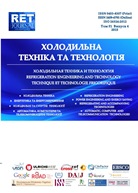STUDIES REFER TO LIQUID OXYGEN AREA OF LIQUID-BASED ROCKET ENGINE FUEL SYSTEMS
DOI:
https://doi.org/10.15673/0453-8307.4/2015.44787Keywords:
Upper oxygen layer heating, hot helium, aero dynamical heating, absence of correlation.Abstract
Hot helium temperature influence on liquid oxygen tank heating process during aero-dynamic heating has been investigated on practice. Tank diameter is 1.25 meters. Tank is made of aluminum alloy. Its upper and down bottoms are heat insulated, internal area is processed with chemical milling. The helium was input into tank center as stream. Aero-dynamic heating was simulated by nitrogen. It was input into annular gap between cylindrical wall and special cover. The value of specific thermal flow was controlled by amount of nitrogen. A time delay with opened drain valve was done after tank fill-up had been finished in order to stabilize fuel component temperature in tank, and tank structure. A tank was refilled to a needed level in case necessity had arisen. The tank pressurization using helium had been done to 3 bar value before oxygen sink. Some investigations were performed with some equal conditions with zero influence – when pressurization gas temperature was close to oxygen temperature inside tank. Oxygen temperatures were measured in different tank height, and in service manifold. A core with 23 temperature detectors was placed inside the tank. Sink time ~ 150 sec. High layer oxygen temperature detection maximum total error was no more than 0.5 K. The correlation absence between input helium temperature in 90-370 K range, and upper oxygen layer in tank heating using higher than 4 kw/m2 outer heat flows to cylindrical tank part was detected. Upper oxygen layer top heat was less than 4 K in testing conditions, gas pressure inside tank – less than 1.9 bars. It is worth using simplified process models which are taking aero dynamical heating into account only, during oxygen heating process mathematical modeling.
References
Degtiarev A.V., Kushnarev A.P. 2014. Raketa kosmicheskogo naznacgeniia sverkhmalogo klasa. Kosmicheskaia tekhnika. Raketnoe vooruzhenie. Sb.nauch.-tekhn. st. GP “KB “Yuzhnoye“, No.1, pp. 14-20 (in Russian).
Beliaev N.M. 1976. Sistemy nadduva toplivnykc bakov roket. Moskva: Mashinostroenie, 336 p.
(in Russian)
Ring Elliot. 1964. Rocket Propellant and Pressuri-zaition Systems. PrenticeHall., Inc., Englewood Cliffs, N.J., 404 p.
Mitikov Yu. 2012. Rachetno-eksperimentalnye issledovaniia sverkhkholodnogo nadduva. Sistemne proektyvannia. Volume XIII, pp. 61-69 (in Russian).


